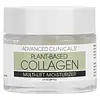Advanced Clinicals Plant Based Collagen Multi-Lift Moisturizer Versus Olay Retinol 24 Night Face Cream
What's inside
What's inside
 Key Ingredients
Key Ingredients

 Benefits
Benefits

 Concerns
Concerns

No concerns
 Ingredients Side-by-side
Ingredients Side-by-side

Water
Skin ConditioningPropanediol
SolventGlycerin
HumectantPyrus Malus Fruit Extract
Skin ConditioningDimethicone
EmollientSclerocarya Birrea Seed Oil
HumectantAmmonium Acryloyldimethyltaurate/Vp Copolymer
Oryza Sativa Extract
AbsorbentAloe Barbadensis Leaf Juice
Skin ConditioningButylene Glycol
HumectantSodium Hyaluronate
HumectantGlycine Max Seed Extract
Skin ConditioningCaulerpa Lentillifera Extract
Rosa Centifolia Flower Extract
AstringentPanax Ginseng Root Extract
EmollientLactobacillus Ferment
Skin ConditioningGlucosamine Hcl
Camellia Sinensis Leaf Extract
AntimicrobialHydroxyethylcellulose
Emulsion StabilisingDaucus Carota Sativa Root Extract
Skin ConditioningChenopodium Quinoa Seed Extract
Skin ConditioningCitrus Paradisi Peel Oil
MaskingOryza Sativa Bran Extract
Skin ConditioningRosmarinus Officinalis Leaf Extract
AntimicrobialPhenoxyethanol
PreservativeHelianthus Annuus Extract
EmollientPalmitoyl Tripeptide-1
Skin ConditioningPalmitoyl Tetrapeptide-7
Skin ConditioningCarbomer
Emulsion StabilisingTetrasodium Glutamate Diacetate
Ascorbic Acid
AntioxidantPolysorbate 20
EmulsifyingTocopherol
AntioxidantMaltodextrin
AbsorbentCaprylyl Glycol
EmollientEthylhexylglycerin
Skin ConditioningSodium Hydroxide
BufferingHexylene Glycol
EmulsifyingCitric Acid
BufferingWater, Propanediol, Glycerin, Pyrus Malus Fruit Extract, Dimethicone, Sclerocarya Birrea Seed Oil, Ammonium Acryloyldimethyltaurate/Vp Copolymer, Oryza Sativa Extract, Aloe Barbadensis Leaf Juice, Butylene Glycol, Sodium Hyaluronate, Glycine Max Seed Extract, Caulerpa Lentillifera Extract, Rosa Centifolia Flower Extract, Panax Ginseng Root Extract, Lactobacillus Ferment, Glucosamine Hcl, Camellia Sinensis Leaf Extract, Hydroxyethylcellulose, Daucus Carota Sativa Root Extract, Chenopodium Quinoa Seed Extract, Citrus Paradisi Peel Oil, Oryza Sativa Bran Extract, Rosmarinus Officinalis Leaf Extract, Phenoxyethanol, Helianthus Annuus Extract, Palmitoyl Tripeptide-1, Palmitoyl Tetrapeptide-7, Carbomer, Tetrasodium Glutamate Diacetate, Ascorbic Acid, Polysorbate 20, Tocopherol, Maltodextrin, Caprylyl Glycol, Ethylhexylglycerin, Sodium Hydroxide, Hexylene Glycol, Citric Acid
Water
Skin ConditioningDimethicone
EmollientGlycerin
HumectantTapioca Starch
Dimethicone Crosspolymer
Emulsion StabilisingRetinyl Propionate
Skin ConditioningCaprylic/Capric Triglyceride
MaskingRetinol
Skin ConditioningPalmitoyl Pentapeptide-4
Skin ConditioningBHT
AntioxidantButylene Glycol
HumectantDimethiconol
EmollientNiacinamide
SmoothingPolysorbate 20
EmulsifyingLaureth-4
EmulsifyingLaureth-7
EmulsifyingDisodium EDTA
Polyacrylamide
Acrylates/C10-30 Alkyl Acrylate Crosspolymer
Emulsion StabilisingAminomethyl Propanol
BufferingPEG-100 Stearate
Ammonium Polyacrylate
StabilisingPolymethylsilsesquioxane
Titanium Dioxide
Cosmetic ColorantC13-14 Alkane
SolventDMDM Hydantoin
PreservativeIodopropynyl Butylcarbamate
PreservativeBenzyl Alcohol
PerfumingMethylparaben
PreservativeWater, Dimethicone, Glycerin, Tapioca Starch, Dimethicone Crosspolymer, Retinyl Propionate, Caprylic/Capric Triglyceride, Retinol, Palmitoyl Pentapeptide-4, BHT, Butylene Glycol, Dimethiconol, Niacinamide, Polysorbate 20, Laureth-4, Laureth-7, Disodium EDTA, Polyacrylamide, Acrylates/C10-30 Alkyl Acrylate Crosspolymer, Aminomethyl Propanol, PEG-100 Stearate, Ammonium Polyacrylate, Polymethylsilsesquioxane, Titanium Dioxide, C13-14 Alkane, DMDM Hydantoin, Iodopropynyl Butylcarbamate, Benzyl Alcohol, Methylparaben
Ingredients Explained
These ingredients are found in both products.
Ingredients higher up in an ingredient list are typically present in a larger amount.
Butylene Glycol (or BG) is used within cosmetic products for a few different reasons:
Overall, Butylene Glycol is a safe and well-rounded ingredient that works well with other ingredients.
Though this ingredient works well with most skin types, some people with sensitive skin may experience a reaction such as allergic rashes, closed comedones, or itchiness.
Learn more about Butylene GlycolDimethicone is a type of synthetic silicone created from natural materials such as quartz.
What it does:
Dimethicone comes in different viscosities:
Depending on the viscosity, dimethicone has different properties.
Ingredients lists don't always show which type is used, so we recommend reaching out to the brand if you have questions about the viscosity.
This ingredient is unlikely to cause irritation because it does not get absorbed into skin. However, people with silicone allergies should be careful about using this ingredient.
Note: Dimethicone may contribute to pilling. This is because it is not oil or water soluble, so pilling may occur when layered with products. When mixed with heavy oils in a formula, the outcome is also quite greasy.
Learn more about DimethiconeGlycerin is already naturally found in your skin. It helps moisturize and protect your skin.
A study from 2016 found glycerin to be more effective as a humectant than AHAs and hyaluronic acid.
As a humectant, it helps the skin stay hydrated by pulling moisture to your skin. The low molecular weight of glycerin allows it to pull moisture into the deeper layers of your skin.
Hydrated skin improves your skin barrier; Your skin barrier helps protect against irritants and bacteria.
Glycerin has also been found to have antimicrobial and antiviral properties. Due to these properties, glycerin is often used in wound and burn treatments.
In cosmetics, glycerin is usually derived from plants such as soybean or palm. However, it can also be sourced from animals, such as tallow or animal fat.
This ingredient is organic, colorless, odorless, and non-toxic.
Glycerin is the name for this ingredient in American English. British English uses Glycerol/Glycerine.
Learn more about GlycerinPolysorbate 20 is made by combining ethoxylation of sorbitan, ethylene oxide, and lauric acid. It is a mild cleansing agent, surfactant, and emulsifier.
As a surfactant, it helps collect dirt and oils for washing. Emulsifiers prevent oils and water from separating.
Polysorbate 20 also adds scent to a product. Since it is made using sorbitol, it has a sweet scent. Sorbitol can also be found in fruits such as apples and peaches.
The lauric acid used to create Polysorbate 20 is often derived from coconuts.
Polysorbate 20 may not be fungal acne safe.
Learn more about Polysorbate 20Water. It's the most common cosmetic ingredient of all. You'll usually see it at the top of ingredient lists, meaning that it makes up the largest part of the product.
So why is it so popular? Water most often acts as a solvent - this means that it helps dissolve other ingredients into the formulation.
You'll also recognize water as that liquid we all need to stay alive. If you see this, drink a glass of water. Stay hydrated!
Learn more about Water